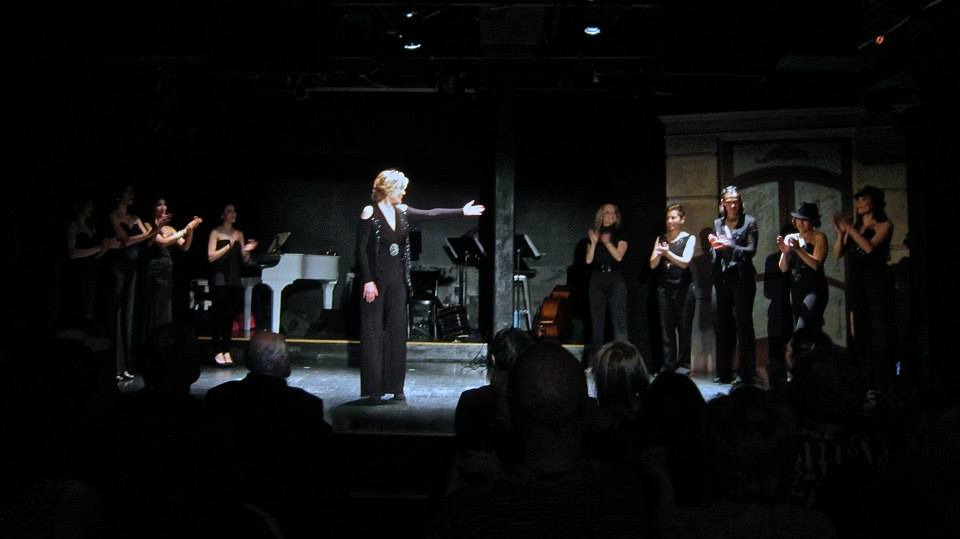Polly Ferman presented her show GLAMOUR TANGO, subtitled “Tango in Feminine Form,” on Monday night at Tango House, using New York based, but international, talent, all of them, appropriately, women. It follows the basic form of a lot of tango shows. There is a live orchestra at the back of the stage, which includes Ayelen Pais Negrin (a very interesting bandoneón player), Ina Paris (on the violin), Yael Acher Modiano (the flautist), and Iris Ornig (on double bass), from, respectively, Argentina, Cuba, Israel, and Germany; Ferman herself, a Uruguayan, is on the piano. The action at the front of the stage is historically driven, serving as a sort of introduction to the form while also conjuring its nostalgia.
The dance numbers are framed and held together by a singer, who assumes various personae as the historical drama progresses, although not, in this case, in a strict linear chronology (a manifestation, perhaps, of “feminine form”). Similarly, the progression of the music is defined by the piano, which Ferman plays with classical delicacy, a lightness of touch that is lovely to hear but rare in tango (another manifestation, perhaps, of the “feminine”). Archival film footage is interspersed with the live performers, documenting the status of women in that history, from being stigmatized actors in a scandalous dance (the subject of the first film clips), to becoming admired singers, dancers, and composers whose contributions are yet underrated by a male establishment.
The whole of which adds up to something quite wonderful, in some ways like any other tango show, but in other ways challenging and provocative. It is remarkable how fluid, and at times irrelevant, the notion of leaders and followers becomes in Mariana Parma’s choreography, at one point resulting in a four way embrace among Parma, Karina Romero, Mariana Glassi, and Ana Padron (Uruguay, Argentina, Argentina, and the U.S., respectively), in, so far as I could see, total role equality. The dancers at one point cross-dress as men, sending up the macho archetypes of tango, the compadritos with their tilted hats. The choreography’s provocative moments are impactful precisely for their casualness, the ways in which they seem normal and ordinary rather than exceptional.
Although the bulk of the show is dance, its dramatic coherence is provided by the songs. The feminine archetypes of tango are displayed in the poetic literature of the lyrics, from Piazzolla’s Maria de Buenos Aires, the eponymous first number, to the milonguita of the streets (who might in English be called a floozy), to, inevitably, Malena, the creature of legend who sings tango “like no other,” including, if one takes the irony of the lyrics at face value, whatever singer is extolling her at the moment. These roles are passed through with a delirious sense of discovery by the Argentinian transplant Sofía Tosello. She has already been, in the city’s music venues, the singer who most stirs to life the soul of this ancestral form; she has now, with astonishing facility, become a stage performer who dons and doffs costumes, and along with them personalities with unique emotions and physical mannerisms, to say nothing of realizing an archetype like Maria, who embodies a city and a whole culture.
The song-centered structure persists almost to the end, when Ferman, the show’s creator and director, orchestrates a finale (to the traditional closing song in tango gatherings) that involves all of the women and all of the nationalities on stage, musicians, dancers, and singer. This was, although I have written about it in the present tense, a one off, but I hope it returns, and has a full run somewhere, so that it can season and grow and develop beyond even the exemplary point it has achieved.
For more information on Glamour Tango, click here. The show will be performed again on Oct. 23, 2016, at (le) poisson rouge.

One response to “Glamour Tango”
[…] She told us at Clásica y Moderna that she would be joining the all-woman cast of Polly Fermen’s Glamour Tango for its China tour, in preparation for which she will pass through New York. If in that journey she […]